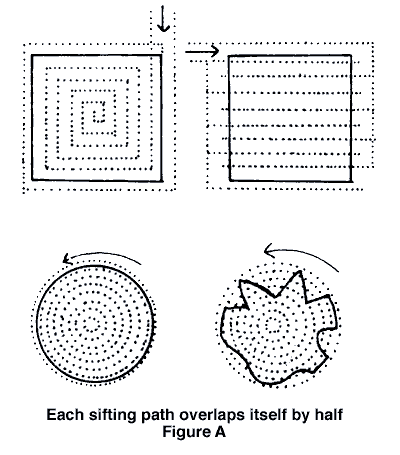Proper Enamel Sifting Process
Sifting is the process of dropping and catching falling enamel particles. The control factors are mesh size of the enamel; mesh size of the screen; the load of the sifter; the size and shape of the surface to be covered; the use or non-use of a holding agent; the desired pattern; the application evenness and thickness and personal motor skills.
5 Minute Read
The simple approach to sifting is the one most often overlooked. There is a tendency to think too much and make the process harder than it should be. Simple direct methods do not have the complexities necessary to make them feel like work. One does not have to struggle to make fine art or the intricacies of fine workmanship. The elementary approach as a foundation is of great importance to the ability of doing.
Applying enamel by sifting is one of those processes where the person in control must overcome great expectations and settle for the basic nature of the process. The process simply must not be made into something more than it is.
Sifting is the process of dropping and catching falling enamel particles. The control factors are mesh size of the enamel; mesh size of the screen; the load of the sifter; the size and shape of the surface to be covered; the use or non-use of a holding agent; the desired pattern; the application evenness and thickness and personal motor skills.
The enamel particles must be able to pass through the screen openings of the sifter. The size of these openings, if large, allow the enamel to pass through most rapidly and in greater quantity. If small, both the speed and the quantity are reduced.
Selection of screen size and particle size help determine the amount of enamel applied to a surface. During the actual sifting process smaller particles fall through the sifter first. If the sifter is overloaded with enamel the weight of enamel compresses reducing the volume of enamel which can pass through the screen. Sifters should not be loaded more than 1/3 full of material if maximum work potential is expected.
The movement, rap or tap of the sifter initiates the enamel fall. This may be accomplished by finger and/or wrist motion of either one or two hands. Intensity of this movement along with the size of the sifter must relate to both the amount of enamel, as well as the area and the surface to be covered. A sifter too small in relationship to the area to be covered effectively decreases both quantity of enamel applied and evenness of overlap. A sifter too large in relationship to the area being covered may increase the quantity of enamel being applied creating an excessive application, waste, or coverage on unwanted areas.
When the enamel particles are sufficiently smaller than the screen size, enamel tends to clump in the fall. This may be due to moisture and the natural attraction of material for itself. If moisture is the problem it can be removed by pre-drying the material just before sifting. The natural attraction or clumping can be reduced by using a mixture of enamel particles too large to pass through the screen to help increase agitation, reduce and divide the small particles passing through.
When enamel particles are large or applied without a mixture of large and small sizes these particles tend to bounce on the surface and/or dislodge those particles already on the surface. This can be controlled with either a good mixture of particle sizes where the smaller particles which fall first will catch the larger particles which fall second and reduce their bounce or by applying a holding agent to the surface collecting the enamel to catch and hold the material thus reducing the bounce. Even if the piece is flat bounce will still occur. This kind of displacement is of major concern when covering non-flat pieces, i.e. cups and deep bowls.
The sifted path should show evenness in both amount and direction. A random sifting will produce a random surface. If that is desired there is no reason not to use such a method, however, if an even color and surface is desired, the enamel must be applied in a logical controlled manner, Figure A.
The sifting of irregularly cut pieces follows the same logic and pattern. If the same pattern is not followed there is a tendency to oversift small areas and undersift large areas.
The sifted falling particles should meet the surface at 900. Any other angle would cause them to deflect. Such deflection could cause previously applied enamel to become dislodged and fall either to an unwanted area or from the piece. This is particularly true when sifting non flat pieces. The principles can be easily observed in Figure C. When sifting a concaved surface the object is held at such an angle as to catch the enamel at 900 at the bottom. The piece is rotated during application for coverage until coverage is completed. Each path of enamel overlaps the last.
The sifted path should first cover the outside edge. The edge of the object should be half way into the sifted fall of the enamel. This ensures edge coverage, Figure B. If the sifter or the piece is moved so as not to completely cover, the edge all too frequently has insufficient enamel coverage.
The falling enamel tends to be heavier in the center of the fall than at the edge. Thus overlapping of the path becomes important. If there is concern that the edge is not sufficiently covered the path should be retraced twice before moving on to cover the rest of the piece.
Steep sided pieces usually have a holding agent used to catch the enamel. (Liquid enamel sprayed is better for this process. However, such equipment may not be available.)
With such a process the logic is not the catch of the enamel, but the bounce. A deep bowl or cup both need the same logic. The amount of enamel being caught becomes important. The excess of enamel will pull the sufficient amount of enamel from the surface creating bare or thin areas.
Alignment of the sifter is not at 90? to the surface. Path of the falling enamel is of complete importance. Beside the rotation of the object the angle changes as the path moves down towards the bottom, Figure D.
The holding agent not only catches the material but it pulls the particles into close alignment, which creates a tighter layer than if sifted dry. The holding agent helps wet the particles and they can draw into a natural alignment.
When sifting, a general principle to understand is to apply enamel to those surfaces which it would more than likely fall from first, leaving those surfaces which it can't fall from for last. If the last were done first it could be displaced due to the angle when attempting to apply enamel to those surfaces from which it would fall. Or excessive enamel would build up on the lower areas which could reduce the effectiveness of the design and color relationships, Figure E. Making sure the flat areas are sifted last with the smaller particle enamel which will not dislodge the enamel on the non flat surfaces.
Like most techniques only practice will improve the skill level. Sifting, like firing is a basic skill primary to most enamelists
You assume all responsibility and risk for the use of the safety resources available on or through this web page. The International Gem Society LLC does not assume any liability for the materials, information and opinions provided on, or available through, this web page. No advice or information provided by this website shall create any warranty. Reliance on such advice, information or the content of this web page is solely at your own risk, including without limitation any safety guidelines, resources or precautions, or any other information related to safety that may be available on or through this web page. The International Gem Society LLC disclaims any liability for injury, death or damages resulting from the use thereof.
The All-In-One Jewelry Making Solution At Your Fingertips
When you join the Ganoksin community, you get the tools you need to take your work to the next level.
Trusted Jewelry Making Information & Techniques
Sign up to receive the latest articles, techniques, and inspirations with our free newsletter.



